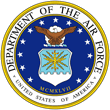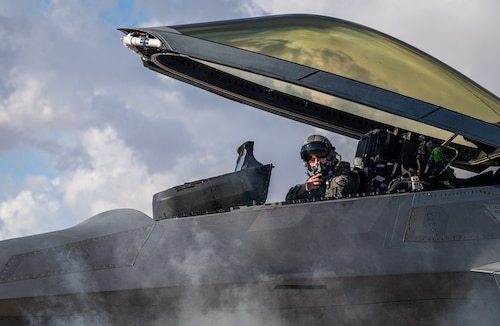3rd Air Expeditionary Wing operates in first-ever iteration of exercise Bamboo Eagle
NELLIS AIR FORCE BASE, Nev. (AFNS) --
“This is our opportunity to see our 3rd Air Expeditionary Wing command-and-control force element, a C2 team made of members from the 3rd Wing and 673rd Air Base Wing, in a combat representative training environment,” said Col. Kevin Jamieson, commander of the AEW commander. “We’ll be practicing the hub-and-spoke concept along with agile combat employment to sustain operations across four spokes for the duration of Bamboo Eagle. The team has already done phenomenal work in getting us prepared to start this exercise, and now it’s time to see what we can do.”
As the host wing for four different spokes, also known as forward operating stations, the 3rd AEW acts as the mission command center, planning, directing and coordinating the four fighter units and one airlift unit at the operational level. The four spokes, all different locations closer to the airspace designated for the exercise, established operational capabilities for secure communications, ground refueling, air mobility teams and aircraft security measures leading up to the official start of the exercise as a facet of the Agile Combat Employment concept.
These small, lithe teams are learning how to quickly and efficiently set up these spokes to ensure they are operationally capable.
Lt. Col. Terry Fregly, 525th Expeditionary Fighter Squadron commander, led the squadron through Red Flag 24-1 operations at Nellis AFB, which also serves as the hub for BE 24-1, and is now leading the 525th EFS operations at Naval Air Station North Island, California, which serves as one of the spokes for BE 24-1.
Fregly said BE 24-1 is crucial because it exercises concepts of distributed control, mission planning, and operations, which enable multiple fighter squadrons dispersed among various installations to complete missions on their own, at the direction of a geographically separated wing operations center.
Distributed control allows subordinate commanders to respond to changes in the operational environment and exploit emergent opportunities. This concept does not dilute the authority of the commander; rather, it proliferates that authority across a command.
“This is a new skillset for the U.S. Air Force and the joint force as a whole,” Fregly said. “The things we’re learning here are how to execute the agile combat employment mission set and how to take the lessons learned here and apply them in operations at home station, so we can train the way we fight.”
Fregly said executing distributed mission planning, execution and debrief drive an opportunity to learn from one mission, or vulnerability period, to the next, while executing these concepts across multiple fighter squadrons and various types of aircraft, simultaneously, for 24 hours a day, over an extended period of time.
Success in future conflict depends on how well U.S. forces combine with the broad range of allied and partner capabilities and expertise to secure common interests and promote shared values. Working closely with sister services to align and synchronize efforts improves joint interoperability and increases timely data-sharing while unifying command and control across all warfighting domains.
“Working with allies and partners is incredibly important,” Fregly said. “We can’t execute any operation across the globe without seamless integration with our allies, joint partners and government agencies. Getting to integrate, train and learn together strengthens our relationships now and will be vital to success for when we have to execute like this for real.”
The first-ever iteration of Bamboo Eagle, a U.S. Air Force Warfare Center-led exercise, kicked off in earnest at Nellis Air Force Base and various locations across the southwestern United States and parts of the Pacific Jan. 26.
“This is our opportunity to see our 3rd Air Expeditionary Wing command-and-control force element, a C2 team made of members from the 3rd Wing and 673rd Air Base Wing, in a combat representative training environment,” said Col. Kevin Jamieson, commander of the AEW commander. “We’ll be practicing the hub-and-spoke concept along with agile combat employment to sustain operations across four spokes for the duration of Bamboo Eagle. The team has already done phenomenal work in getting us prepared to start this exercise, and now it’s time to see what we can do.”
As the host wing for four different spokes, also known as forward operating stations, the 3rd AEW acts as the mission command center, planning, directing and coordinating the four fighter units and one airlift unit at the operational level. The four spokes, all different locations closer to the airspace designated for the exercise, established operational capabilities for secure communications, ground refueling, air mobility teams and aircraft security measures leading up to the official start of the exercise as a facet of the Agile Combat Employment concept.
These small, lithe teams are learning how to quickly and efficiently set up these spokes to ensure they are operationally capable.
Lt. Col. Terry Fregly, 525th Expeditionary Fighter Squadron commander, led the squadron through Red Flag 24-1 operations at Nellis AFB, which also serves as the hub for BE 24-1, and is now leading the 525th EFS operations at Naval Air Station North Island, California, which serves as one of the spokes for BE 24-1.
Fregly said BE 24-1 is crucial because it exercises concepts of distributed control, mission planning, and operations, which enable multiple fighter squadrons dispersed among various installations to complete missions on their own, at the direction of a geographically separated wing operations center.
Distributed control allows subordinate commanders to respond to changes in the operational environment and exploit emergent opportunities. This concept does not dilute the authority of the commander; rather, it proliferates that authority across a command.
“This is a new skillset for the U.S. Air Force and the joint force as a whole,” Fregly said. “The things we’re learning here are how to execute the agile combat employment mission set and how to take the lessons learned here and apply them in operations at home station, so we can train the way we fight.”
Fregly said executing distributed mission planning, execution and debrief drive an opportunity to learn from one mission, or vulnerability period, to the next, while executing these concepts across multiple fighter squadrons and various types of aircraft, simultaneously, for 24 hours a day, over an extended period of time.
Success in future conflict depends on how well U.S. forces combine with the broad range of allied and partner capabilities and expertise to secure common interests and promote shared values. Working closely with sister services to align and synchronize efforts improves joint interoperability and increases timely data-sharing while unifying command and control across all warfighting domains.
“Working with allies and partners is incredibly important,” Fregly said. “We can’t execute any operation across the globe without seamless integration with our allies, joint partners and government agencies. Getting to integrate, train and learn together strengthens our relationships now and will be vital to success for when we have to execute like this for real.”

